Working with five-year-old children is a pleasure. And if until the age of 5 the child still resisted preparing for school, then from this age he dreams of growing up as quickly as possible and becoming a student. Now new knowledge and skills have been discovered, and the maturity of mental functions allows one to concentrate on a task for quite a long time.
In developmental classes, children aged 5-6 years master writing, arithmetic operations, and learn to recognize all the sounds in words. This is also the best time for learning to read; preschoolers study letters with interest and quickly grasp the principle of merging them into syllables.
However, the entire learning process must still be based on play activity, and the classes themselves differ in the variety of means used. Otherwise, “tedious” lessons will only bring irritation, and the baby will lose interest.
Tasks for classes with children 5-6 years old
By the age of 5-6, children have already accumulated quite a large amount of knowledge and skills. Along with increased intellectual capabilities, tasks also become more complex.
Mathematical exercises and assignments
By this age, the child most likely already counts to 10, knows the basic figures and knows how to compare them.
Now the future first-grader needs to learn to operate with numbers up to 10 (subtract and add, comprehend the composition of the first ten), solve puzzles and problems in one step, compare sets (greater than, equal to, less). In addition, before school you need to strengthen the ability to navigate in space, learn forward/reverse order of the number series. Older preschoolers divide a circle or square into several equal parts, learn to write numbers and arithmetic signs.
Try to involve your baby in learning unobtrusively. For example, let him himself pour 5 tablespoons of sugar into the pie according to the recipe and break 3 eggs. Or ask to count out money for travel, change, divide the pie between family members, etc.
Walking board games, in which the number of moves depends on the value of the rolled dice, will also help. The best of them are described in the article “Board games for children 5-6 years old.”
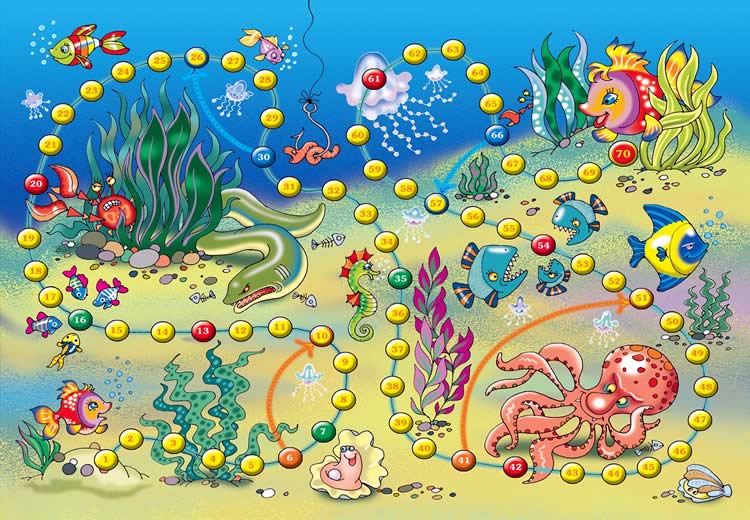
Logic tasks
When preparing for school, parents need to understand that their main task is not to teach their child to quickly read, count and write beautifully. They will be taught this at school too. The main goal there must be a development of mental processes. With well-developed memory, attention and thinking, a little student will always have success in learning. In addition, the development of these same intellectual abilities most effective when the child is small.
Regarding logical thinking During the sixth year, children master the following skills:
- divide objects into groups, naming some characteristic;
- compose a story based on a picture or make up a story from the beginning;
- find an extra item;
- identify a pattern and continue it.
Logical tasks for children 5 years old can be graphic (find something similar, color according to a pattern, go through a labyrinth, complete a drawing, solve a puzzle), verbal (ingenuity problems, riddles), puzzles. All this can be found in printed developmental manuals and programs.
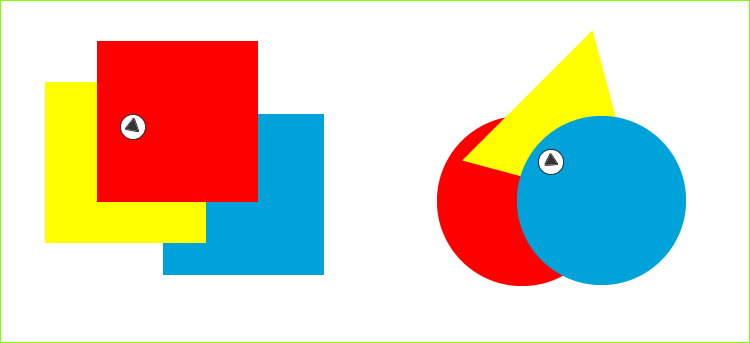
Children, like adults, have different abilities to remember. One thing is certain, memory can be trained. Therefore, when organizing games to develop memory, start small - first offer to remember three objects, then more. As a rule, at the age of 5 years, a child can reproduce 5-6 visual images, 4-5 unrelated words, 3-4 numbers, and repeat 5-6 actions after an adult.
Letter memorization tasks
At school, literacy is taught from sounds to letters. Therefore, before you start learning the alphabet, you need to make sure that the baby can distinguish sounds in a word well and can construct sound scheme words.
To help your child quickly remember the graphic image of a letter, you can sculpt it, figure out what it looks like, and hang cards with letters around the room.
If you have magnetic or wooden letters, you can put them in a bag and take them out by touch. You can also make “relief” letters using cereals, rhinestones and beads.
If the child has already learned letters and knows how to add syllables, you can play with words.
For example, read the word by its first letters.
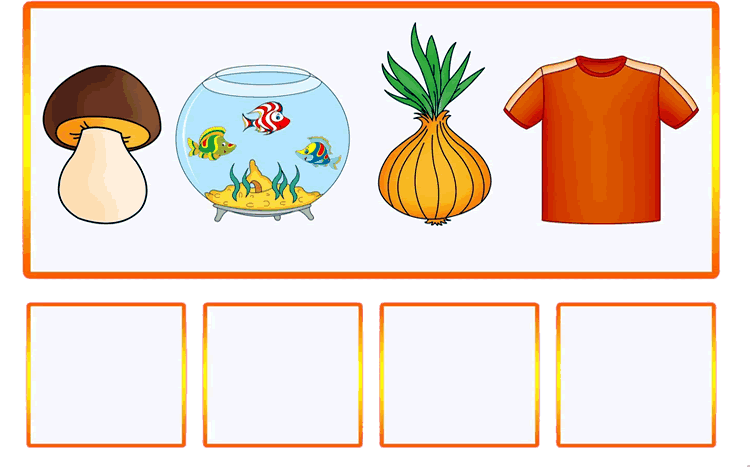
Or think about such a task.
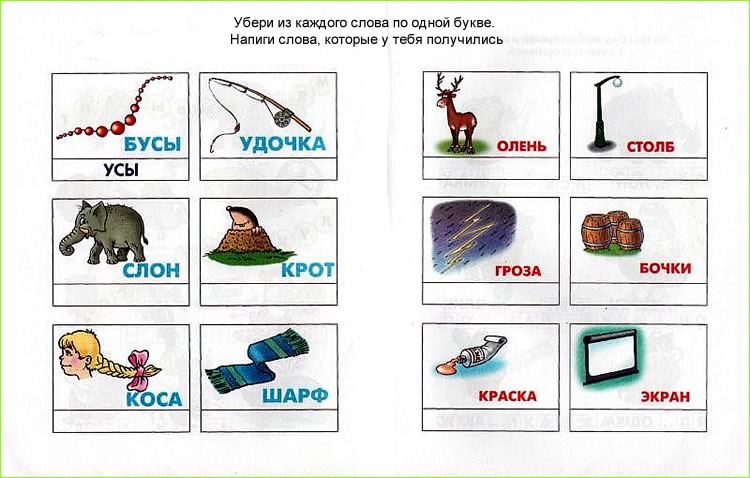
Diversify home literacy lessons and puzzles with letters.
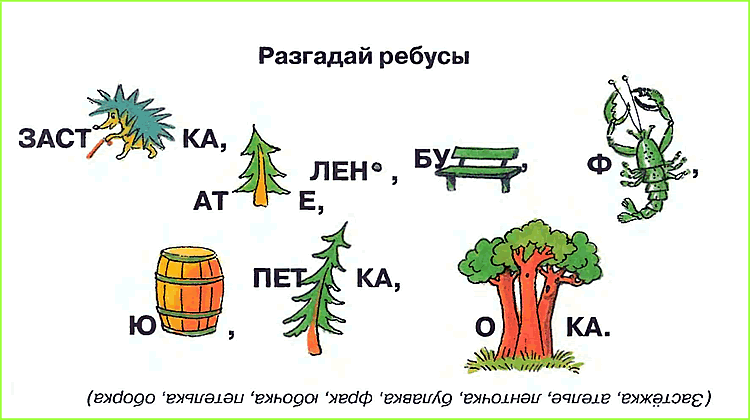
Developing speech
By the age of 5, a preschooler should clearly state not only his first and last name, but also his address, telephone number, and know the details of his parents. In general, the speech of a 5-year-old child is no different from that of an adult. The preschooler correctly uses grammatical norms, can conduct a conversation, build reasoning, and ask questions.
The formation of the sound side of speech is carried out through tongue twisters and articulatory gymnastics. Games for determining the positions of sounds in a word and putting words together from sounds will also help.
For example, a parent pronounces words, and the child, having heard a pre-agreed sound, “catches” them by clapping or jumping.
Thematic material.
The purpose of these didactic games- help adults - parents or educators - prepare the child for school, develop his memory, attention, and thinking. On each page the child is asked to complete a task; the tasks are designed for children 4,5,6 summer age(preschoolers). By completing tasks, children will learn to compare and reason, and develop the ability to think logically. We hope that these entertaining brain teasers will help your baby become more attentive and smart.
4-5 years
In each picture, invite the child to select the missing item by analogy, selecting it from the frame at the bottom of the picture. It’s good if the child independently explains his choice, for example: “The wheel is part of the car, and the window is part of the house. The remaining objects are not suitable, because they are not parts of the house.” If your child is at a loss or gives the wrong answer, prompt him, but do not answer completely for him.
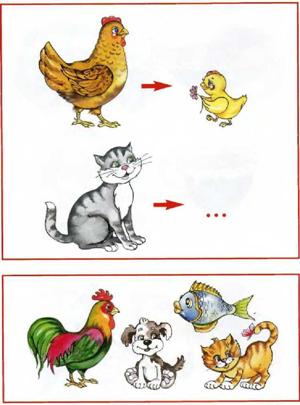
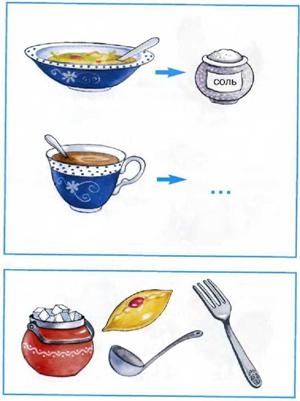
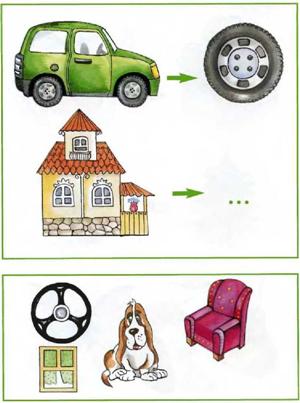
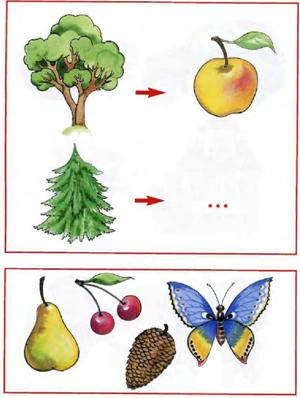
![]()
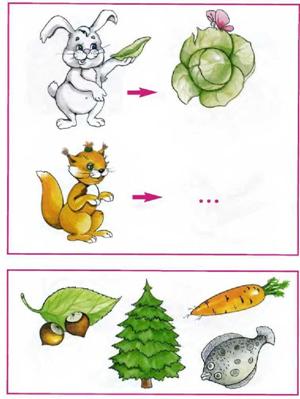
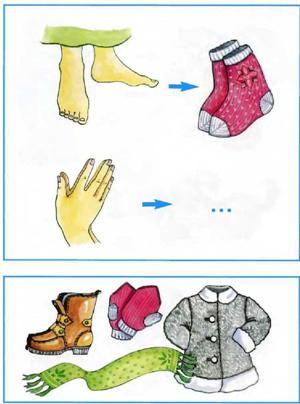
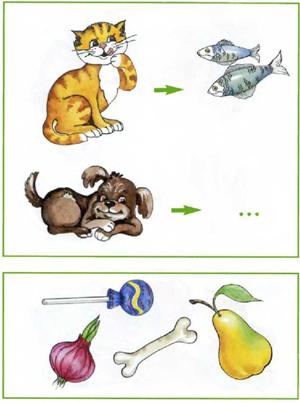
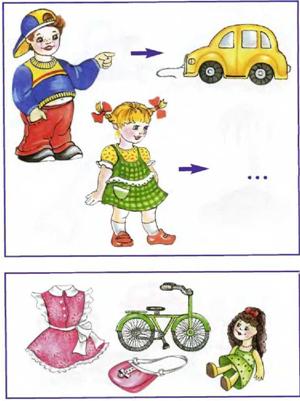
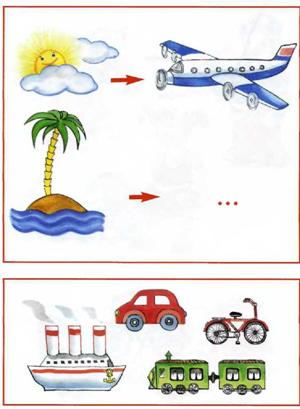
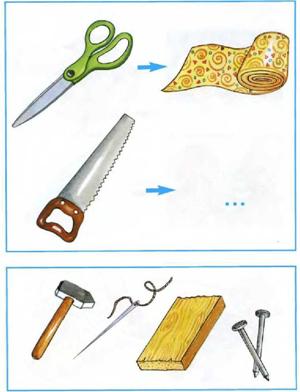
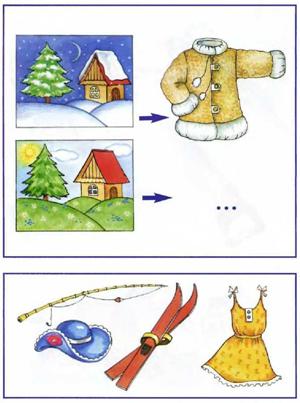
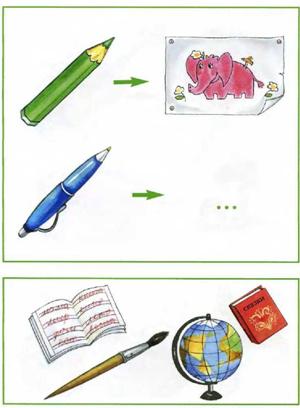
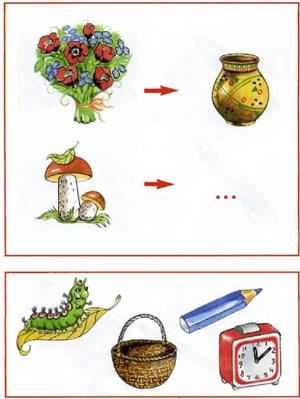
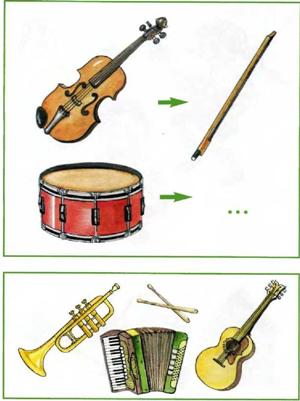
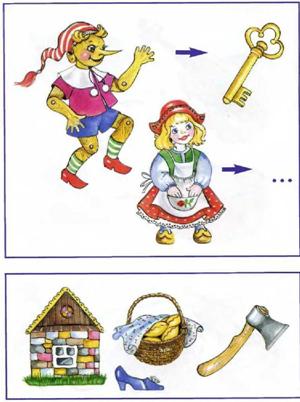
5-6 years
Each picture contains 3 types of tasks. When reading the text of the first task with your child, try to push him to independence, to a creative approach to solving.
When completing the second task, explain to your child that you need to subtract or add other objects from a certain set of objects and draw the resulting answer.
When completing the third task, the child is asked to establish a pattern and select a suitable pair for an object by analogy.
Assignment: “There is a mistake in one of these pictures. Which one? Explain why"
Assignment: “On which plate does the pear lie in front of the apple?”
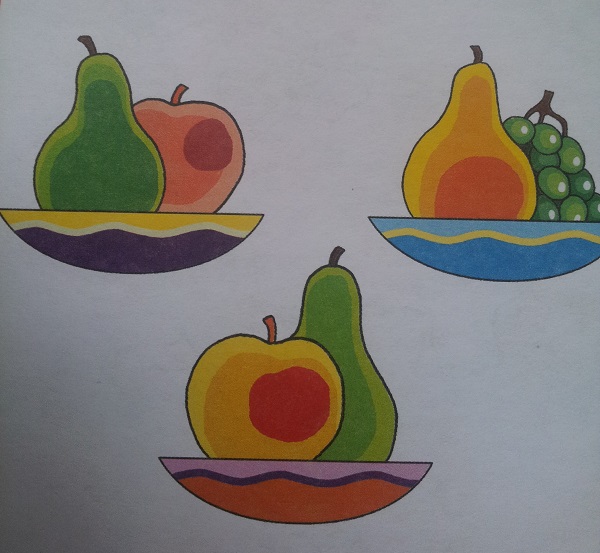
Assignment: “Where is whose shadow?”
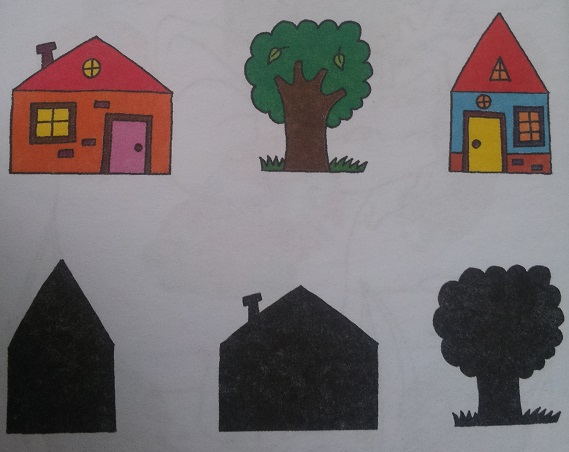
Assignment: “What happens if you cut out a figure drawn on a folded sheet?”
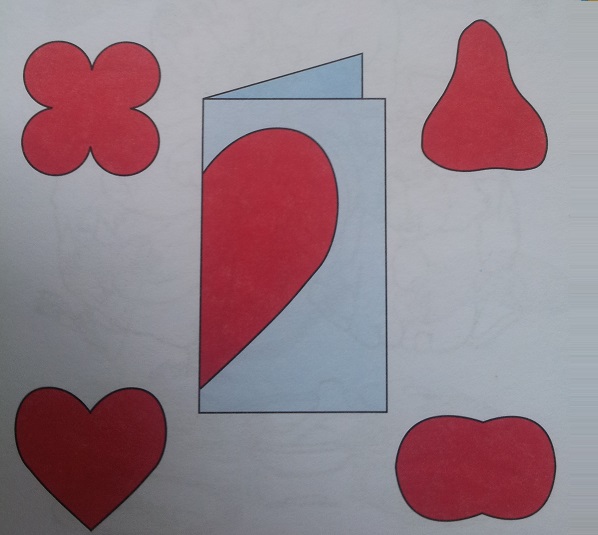
Assignment: “What should be drawn in the empty cell?”
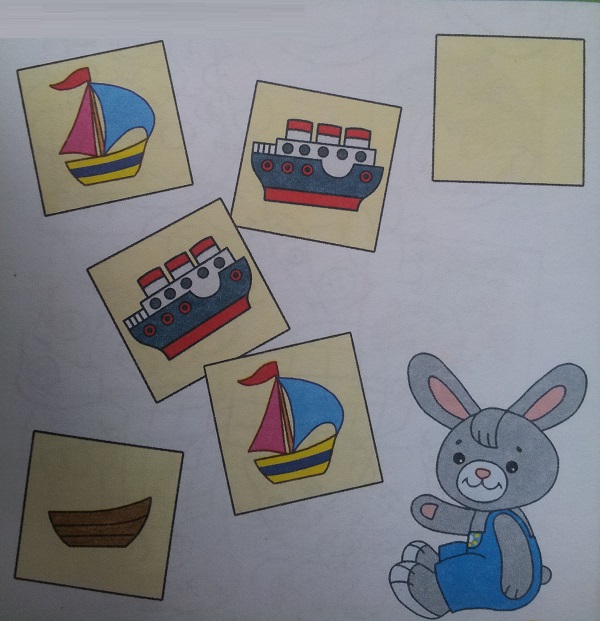
Assignment: “One of these towers must fall. Which?"
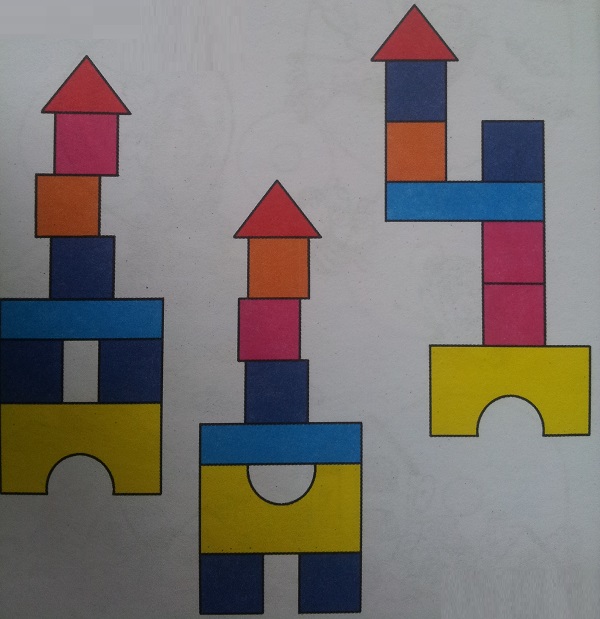
Assignment: “In which picture does the pose of the bear and the bunny coincide with the top picture?”
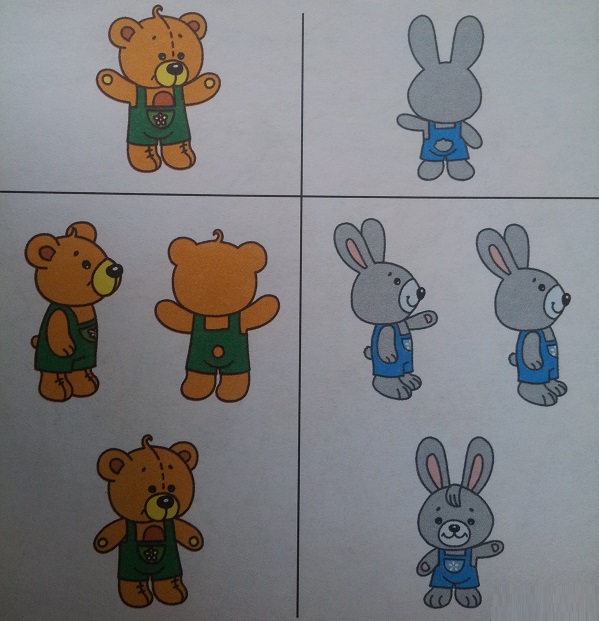
Assignment: “How many black cells does this plump dinosaur cover? Count only whole cells."
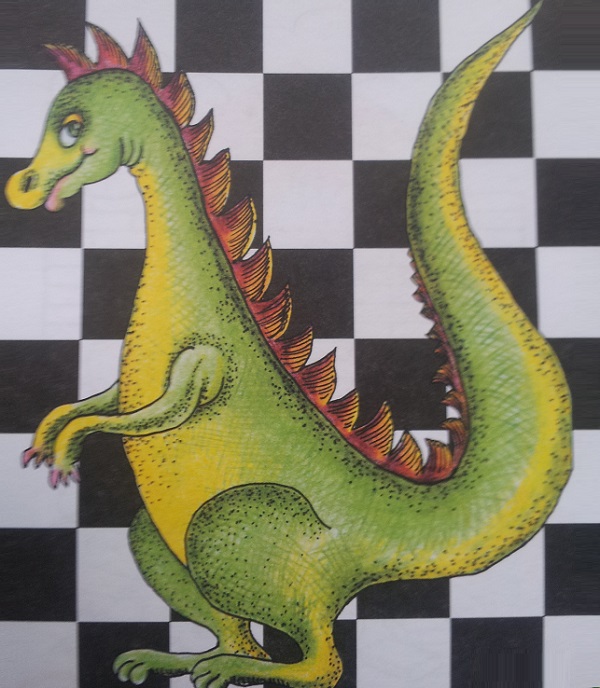
Assignment: “Choose the missing small cube so that each face of the large cube is the same color.”
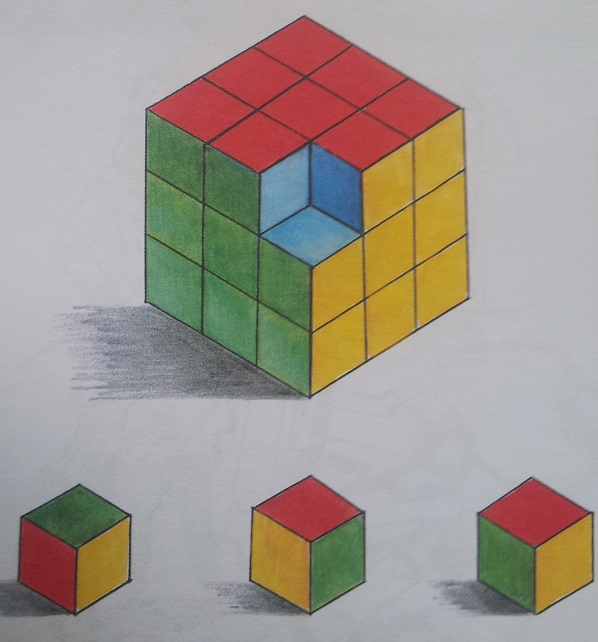
Assignment: “The trainer’s whip is tangled. How many nodes does it have?”
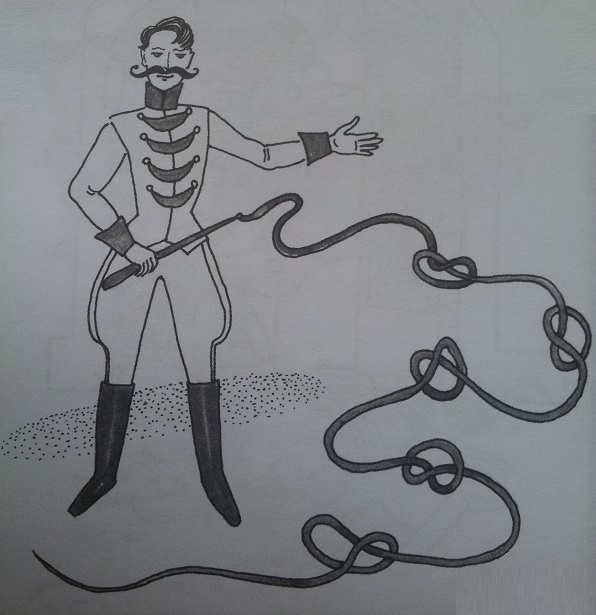
Assignment: “What color is the lowest stick?”
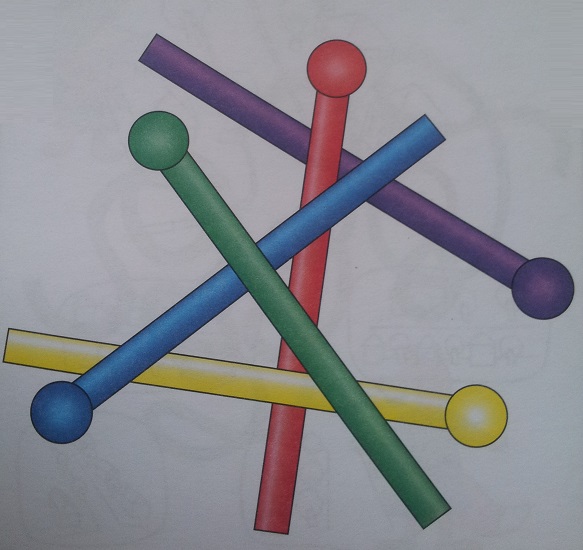
Assignment: “One mouse is about to fall. Which?"
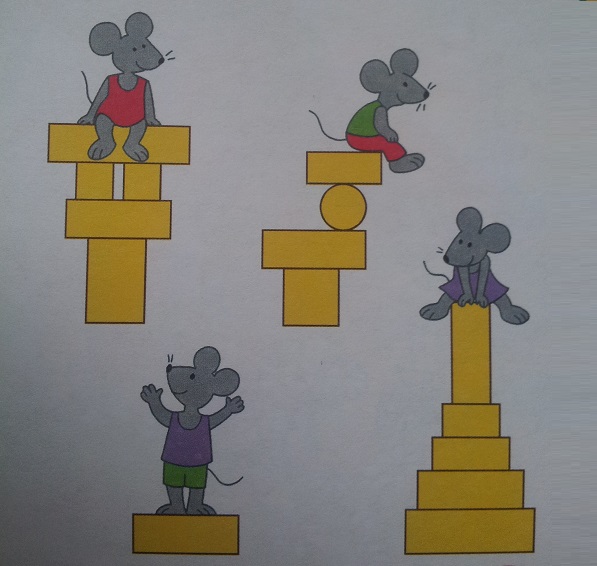
Assignment: “What is close to the girl, what is far?”
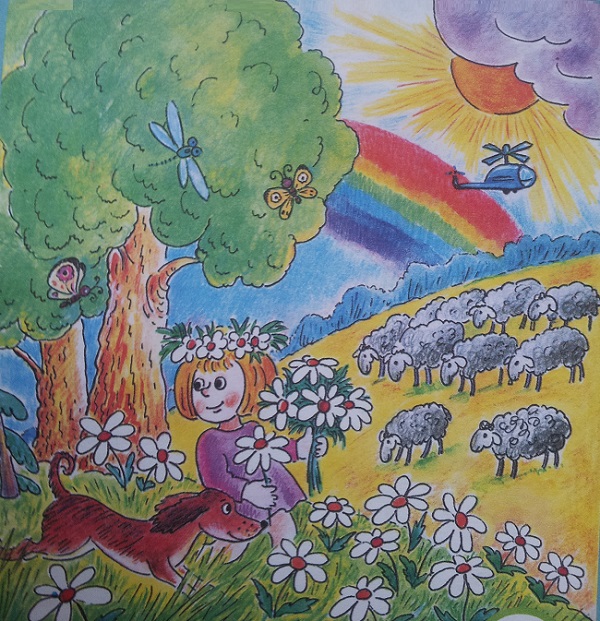
Assignment: “In which pictures will the ropes tie in a knot if you pull their ends?”
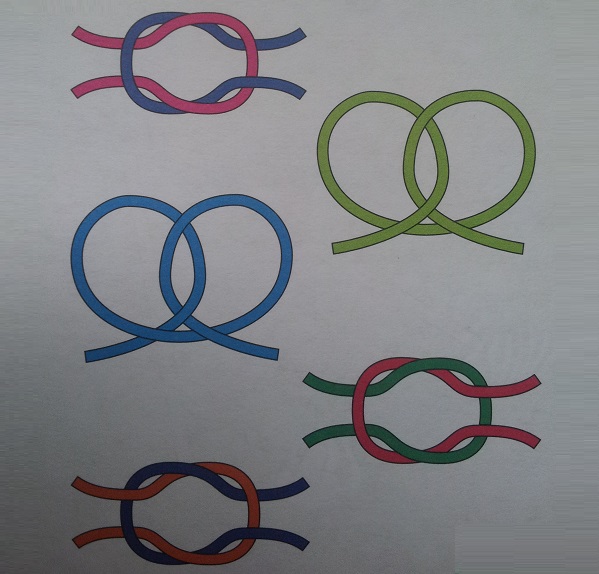
Assignment: “How many animals does the girl see, how many does the boy see, and how many does the father see?”
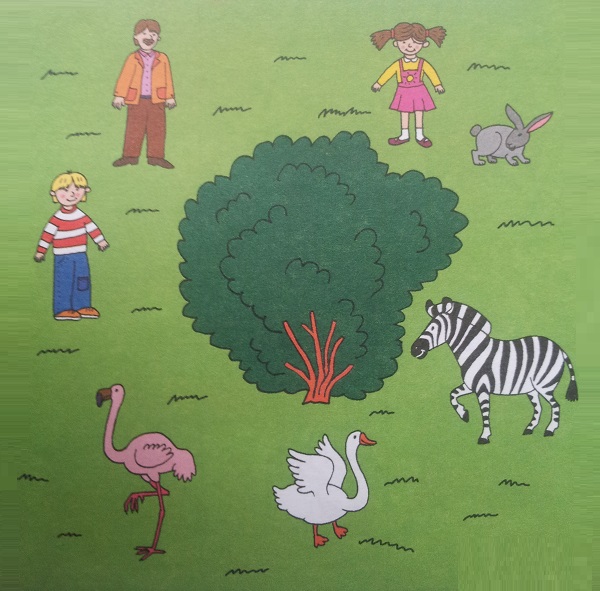
Task: “Divide each chocolate bar into 4 equal parts”
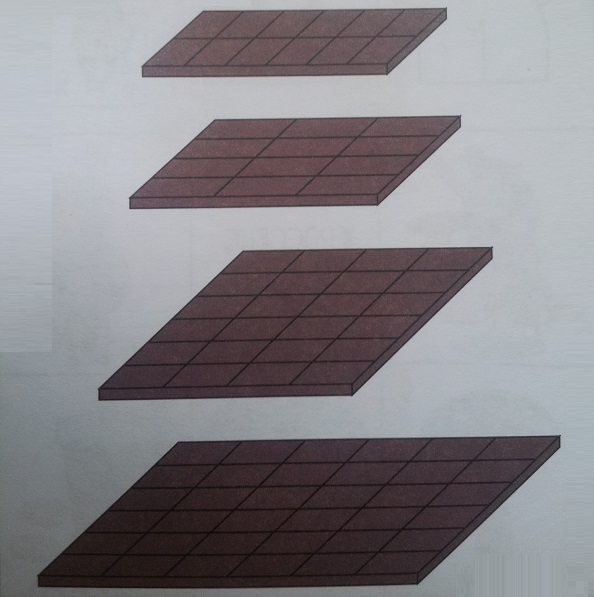
Assignment: “Switch the places of two dancers so that the boys and girls stand next to one.”
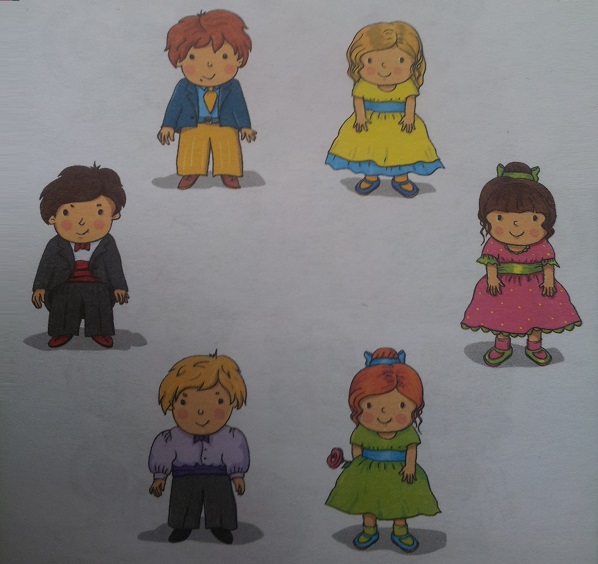
Assignment: “The travelers decided to take a picture of the house. Who got what photo?”
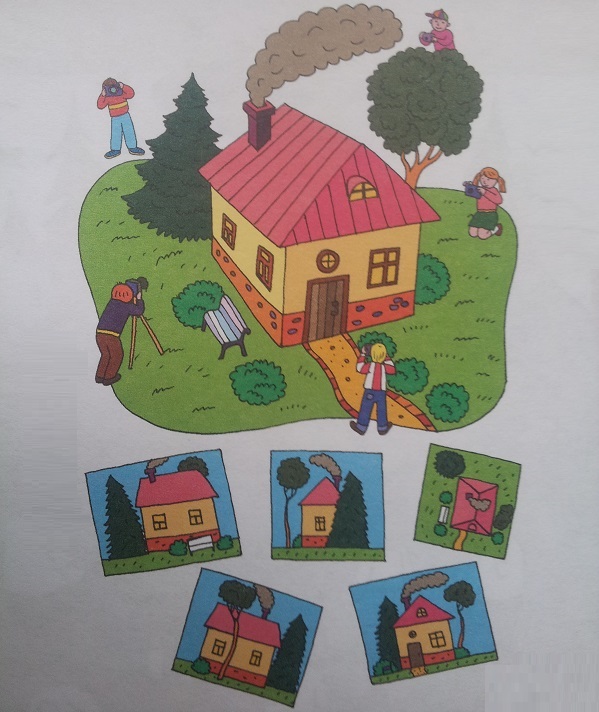
Assignment: “What parts is this boat built from?”
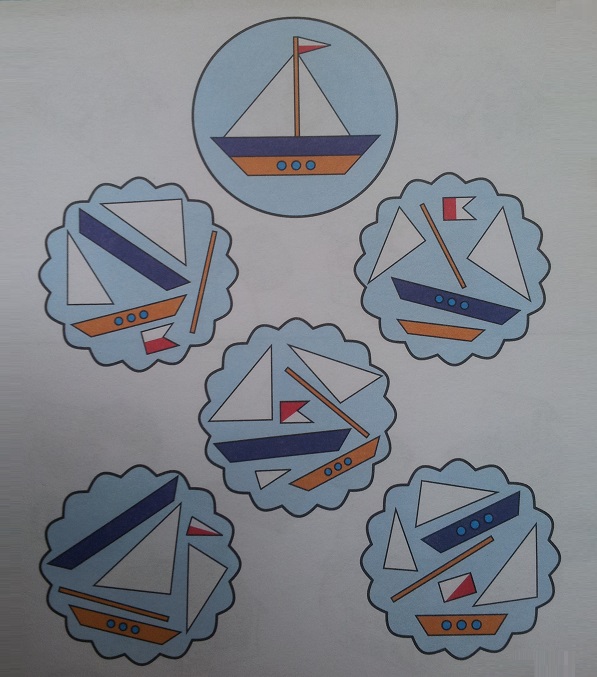
Assignment: “The robot decided to clean up. What did he do wrong? Find eight "irregularities"
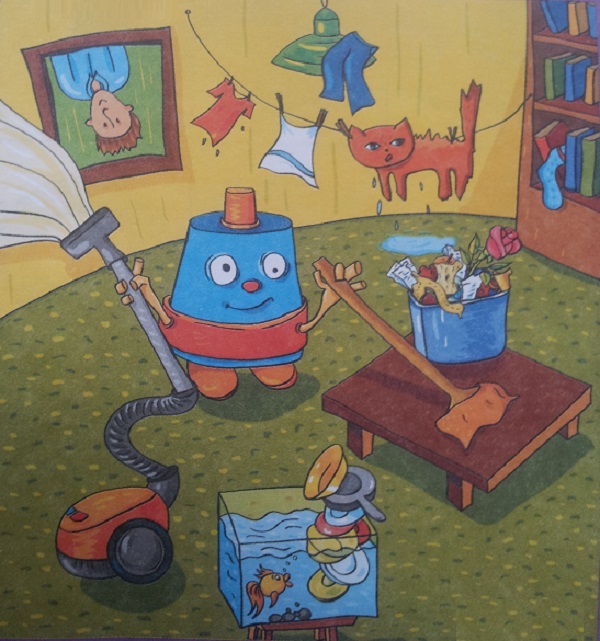
Thinking in children's lives
When a child approaches the age of 5-6 years, parents should pay attention to the level of his thinking. Because the ability to analyze and systematize the information received will improve school performance. Games with geometric shapes help systematize knowledge about the concepts: shape, color and size.
Is it possible to carry a bulky wardrobe along a narrow corridor? What to sew, what to wear to graduation party? How to stand in such a way that each person is clearly visible in the resulting photograph? All these tasks are set for imaginative thinking. The images themselves come in several categories depending on which sense organs are perceived.
Concepts are also included in the category of thinking and together represent irreplaceable elements. With the help of images, you can very quickly make a decision about the production and arrangement of this object. Of course, it is necessary to have the internal ability to manipulate images (mentally rotate objects), transform them and combine them. This kind of thinking is vital, but it doesn’t happen right away.
Small children should not cross the street alone, as they are not yet able to correctly assess the correct distance between them and the car. Such an ability will be formed only by the age of 15. The received information about images is perceived instantly, in a few milliseconds.
Retelling what you saw or read will take much longer than the fleeting run of a cat, and, moreover, it will not always be complete, because for many phenomena there are simply no suitable names or words. Those properties of an object that are reflected in images can be placed within a narrow conceptual framework. They cannot be divided into essential and non-essential. This ability of images is very valuable when solving problems.
With the help of figurative thinking, you can see various properties of an object (including those that are usually considered unimportant in concepts) and, already using these properties, identify connections between objects.
At the end of the 20th century, photography, film, and television significantly simplified the creation and transformation of images compared to traditional drawing techniques. Now it has become much easier to clearly show the subject under discussion, show the dynamics of change, and identify various possible outcomes of an event. This greatly helps to carry out quality work, making a person’s life easier.
To solve assigned problems, a person uses certain algorithms and action patterns. These algorithms are composed of both images and concepts. Operating with formal knowledge, a person projects new, unique images in his mind that will help him in the future to cope with tasks faster. Therefore, for high-quality activity it is necessary both to think in images and to operate with concepts that have long been known to everyone.
Video about how to develop children's thinking using cardboard and scissors
(5-7 years) is the period of formation in a child of knowledge and skills that he will later need at school and in life. At this time, children go through a period of “why”, and the children begin to be interested in more global issues. A preschooler should already be able to read, count to 10, and know the names of the basic geometric shapes on the plane and in volume. The formation of the concepts of “good and bad” is very important during this period. At 5 years old, a child can already concentrate well on a specific task and complete it without distraction. That is why at this age it is necessary to develop the child in all directions. Assignments for a 5-year-old child will help him prepare as much as possible for school.
Speech development in a preschooler
As a rule, at this age children already speak well. They know many words, can construct complex sentences, and also describe events and objects using synonyms and antonyms. Children aged 4-5 years listen very carefully to how adults speak and copy their communication style. It is very important that a five-year-old child learns to pronounce every sound and word correctly. In order for a child’s speech to be clear and sonorous, it is necessary to perform speech development exercises with him.
Speech therapy classes
Speech therapy tasks for children 5 years old are divided into several categories: finger gymnastics and tongue twisters. Tasks using fingers are very conducive to speech development, articulatory gymnastics allows you to correctly open your mouth and position your tongue while pronouncing sounds; tongue twisters, in turn, reinforce the acquired knowledge. Let's look at each of the categories separately.
Finger gymnastics
An example of a development task for a 5-year-old child fine motor skills: "Flower"
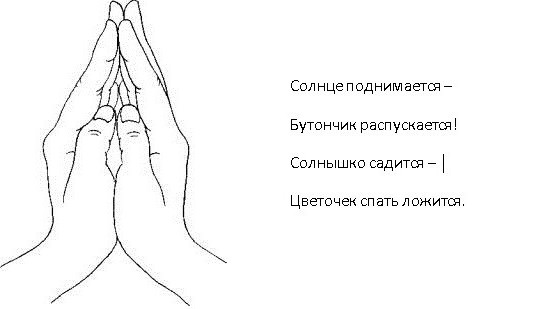
Fold your hands so that they form a flower bud. When reading a poem, open the flower at the words “blooms,” and close the flower at the word “lays down.”
Articulation gymnastics
Articulatory (facial) gymnastics are exercises to develop the muscles of the tongue and lips. If these parts of the child’s body are not sufficiently developed, then he will not be able to pronounce sounds correctly and clearly. It is recommended to complete tasks for a 5-year-old child to develop articulation near a mirror.
- Ask your baby Let him imagine that the tongue is a swing, and swing it on the count of one - towards the upper teeth, on the count of two - towards the lower teeth.
- Exercises with lips: on the count of one, stretch your lips into a tube, on the count of two, smile widely. You can also try scratching your upper and lower lip with your teeth.
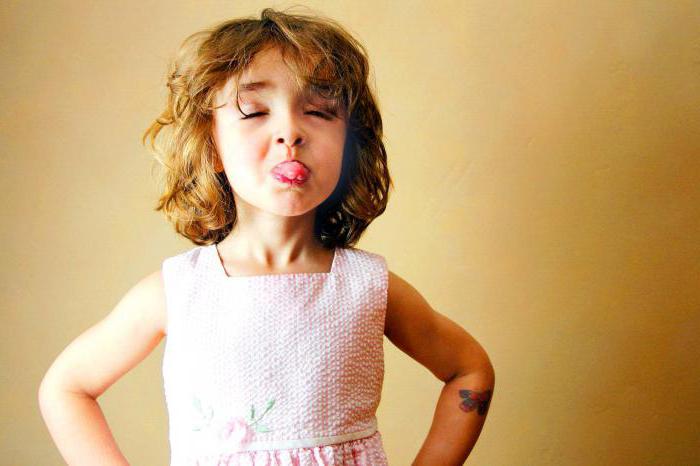
Tongue twisters
There are a huge number of tongue twisters for each sound. All of them help develop the child’s speech: make it clearer and more expressive.
Developmental tasks for children 5 years old in the form of tongue twisters:
![]()
Such tongue twisters teach you to pronounce the sounds [t][d][h]. Children really enjoy reading and learning such funny rhymes.
Developing memory
A child’s memory must begin to develop as early as preschool age. At the age of 5, children perceive and remember new information very well, and in order for such results to be maintained in the future, some effort must be made. So what developmental tasks for 5-year-old children help train their memory?
- Memorizing objects. Place 4 different objects in front of your baby (for example: a car, a pen, a phone and keys). Ask your child to take a good look at them and turn away. Move objects out of sight. Now, when the child turns around, ask him to name what he saw before. If this is not difficult for him, complicate the exercise - ask the color of the objects, shape, purpose.
- Memorizing words (objects and actions). Say 4 different words in a row (objects - table, cup, house, flower, or 4 different actions - sit, read, play, laugh) and ask the child to repeat them. If such tasks for a 5-year-old child turn out to be easy, feel free to use 5-7 words.
- “Spot the difference” pictures, as well as reading and analyzing books you’ve read, help train your memory. For example, start reading a long fairy tale to your child. Read half and leave the rest for the next day. Before reading the next part, ask your child what he remembers from the previous one, analyze together the characters and events of this story.
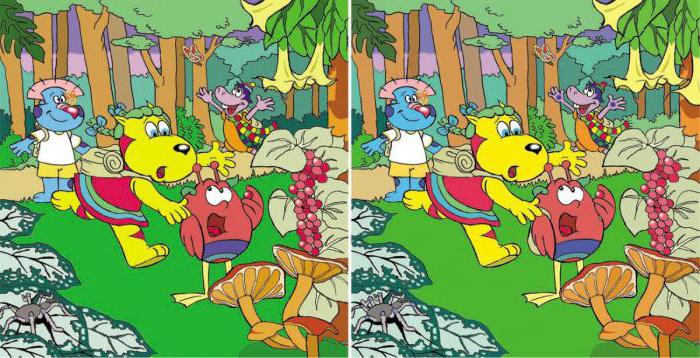
Developmental tasks for logic
Logic is a very important ability that needs to be developed. The thinking of a child at the age of 5 is very unique. Surely many mothers have noticed that at this age children are sometimes smarter than adults. It is very important not to miss this period and help the child develop.
Before studying for children 5 years old, it is necessary to determine what types of thinking a child at this age already operates on. As a rule, at 5 years old children are able to compare, analyze, classify and synthesize objects and actions.
Exercise “Complete the Draw”
The bottom line is that the child needs to finish drawing part of the object.
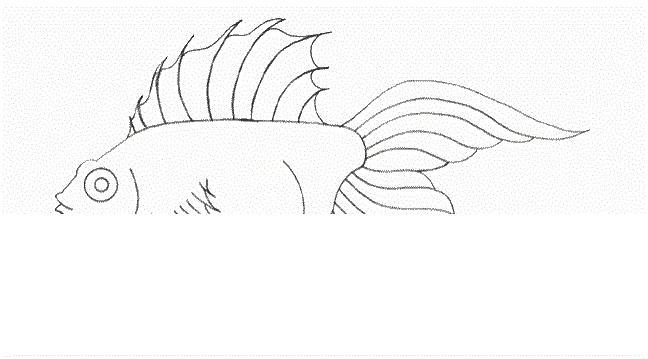
Children's puzzles help develop logic. Putting together puzzles with the whole family is a very fun and rewarding activity. In addition, math assignments for 5-year-old children help develop thinking. For example, place 8 coins on the table and give your child matches. Ask him to put as many matches as coins on the table.
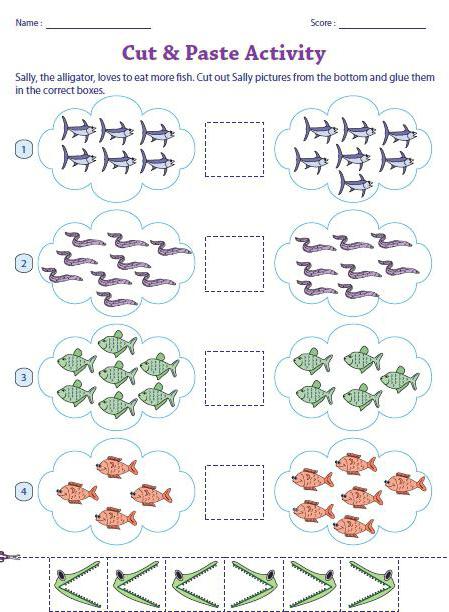
Spend at least 30 minutes every day. However, you should not overtire or force your baby; be sure to take breaks for gymnastics. The process of studying with a child should look like an exciting game for him, and then he will learn and remember everything well.



